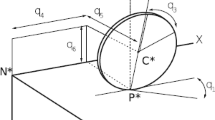Abstract
Computing dynamical equations of motion for systems that evolve on complex nonlinear manifolds in a coordinate-free manner is challenging. Current methods of deriving these dynamical models is only through cumbersome hand computations, requiring expert knowledge of the properties of the configuration manifold. Here, we present a symbolic toolbox that captures the dynamic properties of the configuration manifold, and procedurally generates the dynamical equations of motion for a great variety of systems that evolve on manifolds. Many automation techniques exist to compute equations of motion once the configuration manifold is parametrized in terms of local coordinates, however these methods produce equations of motion that are not globally valid and contain singularities. On the other hand, coordinate-free methods that explicitly employ variations on manifolds result in compact, singularityfree, and globally-valid equations of motion. Traditional symbolic tools are incapable of automating these symbolic computations, as they are predominantly based on scalar symbolic variables. Our approach uses Scala, a functional programming language, to capture scalar, vector, and matrix symbolic variables, as well as the associated mathematical rules and identities that define them. We present our algorithm, along with its performance, for computing the symbolic equations of motion for several systems whose dynamics evolve on manifolds such as \(\mathbb {R}, \mathbb {R}^{3}, S^{2}, SO(3)\), and their product spaces.
Access this chapter
Tax calculation will be finalised at checkout
Purchases are for personal use only
Preview
Unable to display preview. Download preview PDF.
Similar content being viewed by others
References
List of computer algebra systems. http://en.wikipedia.org/wiki/List of computer algebra systems.
Symbolic Math Toolbox. Mathworks Inc, 1993.
Mathematica Version 10.0. Wolfram Research Inc., 2014.
S. P. Bhat and D. S. Bernstein, “A topological obstruction to continuous global stabilization of rotational motion and the unwinding phenomenon,” Systems & Control Letters, vol. 39, no. 1, pp. 63–70, 2000.
P.-y. Cheng, C.-i. Weng, and C.-k. Chen, “Symbolic derivation of dynamic equations of motion for robot manipulators using piogram symbolic method,” IEEE Journal of Robotics and Automation, vol. 4, no. 6, pp. 599–609, 1988.
L. Consolini and M. Tosques, “On the exact tracking of the spherical inverted pendulum via an homotopy method,” Systems & Control Letters, vol. 58, no. 1, pp. 1–6, 2009.
P. I. Corke, “An automated symbolic and numeric procedure for manipulator rigidbody dynamic significance analysis and simplification,” in IEEE Conf. on Robotics and Automation, 1996, pp. 1018–1023.
T. Daly, D. V. Chudnovsky, and G. V. Chudnovsky, Axiom The 30 Year Horizon. The Axiom Foundation, 2007.
E. Dean-leon, S. Nair, and A. Knoll, “User friendly matlab-toolbox for symbolic robot dynamic modeling used for control design,” in IEEE Conf. on Robotics and Biomimetics, 2012, pp. 2181–2188.
I. DigiArea, Atlas 2 for Mathematica, 2012. [Online]. Available: http://www.digi-area.com/Mathematica/atlas/guide/Atlas.php
R. Featherstone and D. Orin, “Robot dynamics: equations and algorithms,” in IEEE Conf. on Robotics and Automation, 2000, pp. 826–834.
R. P. Feynman, “The principle of least action in quantum mechanics,” Ph.D. dissertation, Princeton University Princeton, New Jersey, 1942.
T. Flaherty, “Scala Math DSL,” https://github.com/axiom6/ScalaMathDSL, 2013.
M. G. Hollars, D. E. Rosenthal, and M. A. Sherman, SD/FAST users manual. Symbolic Dynamics Inc, 1991.
W. Khalil, F. Bennis, C. Chevallereau, and J. Kleinfinger, “Symoro: A software package for the symbolic modelling of robots,” in Proc. of the 20th ISIR, 1989.
E. Kreuzer and W. Schiehlen, “Neweul software for the generation of symbolical equations of motion,” in Multibody Systems Handbook. Springer, 1990.
T. Lee, “Computational geometric mechanics and control of rigid bodies,” Ph.D. dissertation, University of Michigan, Ann Arbor, 2008.
T. Lee, M. Leok, and N. H. McClamroch, “Lagrangian mechanics and variational integrators on two-spheres,” International Journal for Numerical Methods in Engineering, vol. 79, no. 9, pp. 1147–1174, 2009.
T. Lee, M. Leok, and N. H. McClamroch, “Lagrangian mechanics and variational integrators on two-spheres,” J. for Numerical Methods in Engineering, vol. 79, pp. 1147–1174, 2009.
T. Lee, M. Leok, and N. H. McClamroch, “Stable manifolds of saddle equilibria for pendulum dynamics on S2 and SO(3),” in IEEE Conf. on Decision and Control, 2011, pp. 3915–3921.
T. Lee, M. Leok, and N. H. McClamroch, “Dynamics and control of a chain pendulum on a cart,” in IEEE Conf. on Decision and Control, 2012, pp. 2502–2508.
R. Lot and M. D. A. Lio, “A symbolic approach for automatic generation of the equations of motion of multibody systems,” Multibody System Dynamics, vol. 12, pp. 147–172, 2004.
P. X. Miranda, L. Hera, A. S. Shiriaev, B. Freidovich, S. Member, U. Mettin, and S. V. Gusev, “Stable walking gaits for a three-link planar biped robot with one actuator,” IEEE Trans. on Robotics, vol. 29, no. 3, pp. 589–601, 2013.
G. Nonlinearity, “Adams 2014,” pp. 1–5, 2014.
M. Odersky and Al., “An Overview of the Scala Programming Language,” EPFL, Lausanne, Switzerland, Tech. Rep. IC/2004/64, 2004.
A. K. Sanyal and A. Goswami, “Dynamics and balance control of the reaction mass pendulum: A three-dimensional multibody pendulum with variable body inertia,” J. Dyn. Sys., Meas., Control, vol. 136, no. 2, p. 021002, Nov. 2013.
D. Services, “LMS Virtual . Lab The Unified Environment for Functional Performance Engineering,” pp. 1–16, 2007.
J. Shen, A. K. Sanyal, N. A. Chaturvedi, D. Bernstein, and H. McClamroch, “Dynamics and control of a 3d pendulum,” in IEEE Conf. on Decision and Control, 2004, pp. 323–328.
K. Sreenath, T. Lee, and V. Kumar, “Geometric control and di.erential flatness of a quadrotor UAV with a cable-suspended load,” in IEEE Conf. on Decision and Control, 2013, pp. 2269–2274.
SymPy Development Team, SymPy: Python library for symbolic mathematics, 2014. [Online]. Available: http://www.sympy.org
Author information
Authors and Affiliations
Editor information
Editors and Affiliations
Rights and permissions
Copyright information
© 2020 Springer Nature Switzerland AG
About this chapter
Cite this chapter
Bittner, B., Sreenath, K. (2020). Symbolic Computation of Dynamics on Smooth Manifolds. In: Goldberg, K., Abbeel, P., Bekris, K., Miller, L. (eds) Algorithmic Foundations of Robotics XII. Springer Proceedings in Advanced Robotics, vol 13. Springer, Cham. https://doi.org/10.1007/978-3-030-43089-4_22
Download citation
DOI: https://doi.org/10.1007/978-3-030-43089-4_22
Published:
Publisher Name: Springer, Cham
Print ISBN: 978-3-030-43088-7
Online ISBN: 978-3-030-43089-4
eBook Packages: Intelligent Technologies and RoboticsIntelligent Technologies and Robotics (R0)




